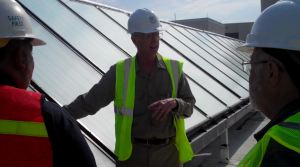WTU Solar Hot Water System Video #2
Have you ever wondered exactly what’s going on inside the flat plate collectors of a solar hot water system? In this video I provide some insight into that question during our training session for NAVFAC. If you look inside a typical flat plate collector, you will see individual black plated copper fins. Manufacturers have different methods for coating the fins to absorb solar radiation. Special coatings that are sputtered or electroplated onto the copper surface don’t re-radiate energy as ordinary objects do. They are called “selective surfaces”. These absorber plates can absorb up to 97% of the energy that falls on them and can re-radiate as little as 5% of that energy. A typical black body (meaning ordinary radiator) can re-radiate as much as 40% of the energy striking it. So, selective surfaces waste far less of the energy captured compared to ordinary black body surfaces.
The glass face plate that covers the collector has a small speckled pattern, called stipple, that helps reduce glare and makes the interior less visible. The guts of a solar collector are not pretty, so the stipple pattern obscures the view a little. Glass reflects about 4% of the sunlight that hits it at 90º (perpendicular). Some light is absorbed and scattered going through the glass, and another 4% is reflected at the inside surface. All this means that about 90% of the sunlight that strikes the surface of an 1/8″ thick solar glass plate gets through to hit the absorber. If the absorber can capture 97% of that, then a good solar thermal collector has a theoretical upper end efficiency of about 87%. However, most of them top out at about 70% in actual testing because the light comes from many angles with higher reflection and several other factors, such as the box edges shading the absorber plate. Not bad when you compare that to most photovoltaic panels in the marketplace right now with efficiencies around 15%. PV technology continues to improve and I read that one company is claiming 22% efficiency. Heat is the enemy of PV panels, so we will have to see how these perform in the real world.
Let me hear your feedback regarding solar hot water systems,
Dr. Ben

